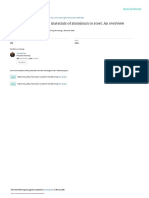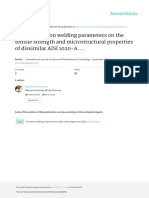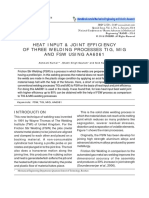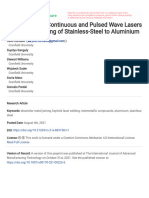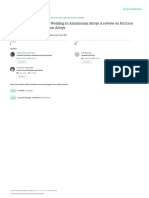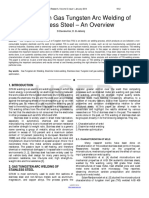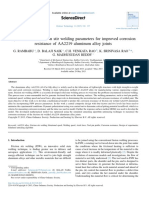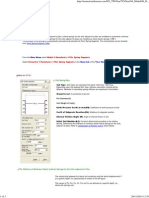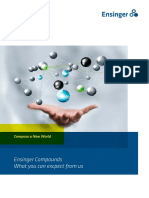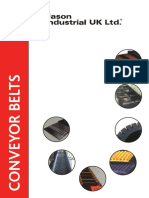Professional Documents
Culture Documents
Process Optimization of Preheated Friction Stir Welded Ferrous and Non Ferrous Materials
Copyright
Available Formats
Share this document
Did you find this document useful?
Is this content inappropriate?
Report this DocumentCopyright:
Available Formats
Process Optimization of Preheated Friction Stir Welded Ferrous and Non Ferrous Materials
Copyright:
Available Formats
Volume 3, Issue 3, March– 2018 International Journal of Innovative Science and Research Technology
ISSN No:-2456-2165
Process Optimization of Preheated Friction Stir
Welded Ferrous and Non-Ferrous Materials
Prashant S Humnabad Dr. M S Ganesha Prasad
Research Scholar, Department of Mechanical Engineering Professor and Head, Department of Mechanical Engineering
Sir M Visvesvaraya Institute of Technology New Horizon College of Engineering,
Bengaluru, Karnataka, India Bengaluru, Karnataka, India
Abstract:- Joining of Ferrous and Non-Ferrous materials, have different thermal and mechanical properties. The sound
such as aluminum and steel alloys is very challenging joint is the highest concern through the design of the parts
which requires the efficient and economic processes. The especially for such places where the quality of the joints has
Al/Steel combination have wide range of industrial more priority than other concerns.
application especially in automotive sector looking for
It is assumed that the new replacement of the light
lightweight materials and provides good strength. As we
materials is that it will help to reduce the fuel consumption,
know aluminum and steel alloys have different
production cost and effectively reduces the amount of human-
metallurgical properties it is quite difficult to join them
elemental energies on the heavier materials. For instance, the
with fusion welding methods. Friction Stir Welding (FSW)
use of the aluminum/steel alloys and finding the surrogating
process (also referred as green joining technology) is most
material for some of the sensitive components is relatively
suitable technology to join dissimilar materials like
influenced by the controlling forces like current regulations to
Al/Steel, which was developed way back in 1991 by The
encounter fuel efficiency standards by decreasing vehicle
Welding Institute (TWI). Earlier FSW was used to join
weight [1, 2].
softer material such as aluminum alloys and the process
has been expanded to weld the materials having higher There are, however, numbers of works on the
strength. To join high strength materials large forces are application of different welding technologies to bond
required, due to this tool wear have become major issue. dissimilar alloys but the problem of losing the strength in the
To resolve this issue, an additional heating source is bond areas is always a big challenge because of the formation
introduced in front of the Friction Stir Welding tool which of the brittle intermetallics has not been solved [3,4].
softens the base material to be welded and reduces the load
on tool hence no mimized tool wear. Present work focused Subsidiary precipitates created during solidification,
to join Ferrous and Non-Ferrous materials like A6082-T6 different thermal properties, dissimilar thermal expansion, heat
capacity and thermal conductivity, large difference between
and Steel and evaluate the effect of parameters considered
the melting points (around 650 °C for Al alloy and 1457 °C for
on tensile strength. Taguchi parametric design approach
steel) and nearly zero solid solubility of iron in aluminum are
was used to determine process parameters, post welding
creating the large discrepancy between the metals leading to
the results are analyzed by using ANOVA statistical tools.
the reduction of the mechanical properties after the joining
The best welding quality is found out by comparing the
processes. Laser roll bonding [5], impact welding [6], friction
result obtained from tensile testing showed that due to
welding [7], ultrasonic welding [8], diffusion bonding [9],
preheating of base metal, increase in material flow and
explosive welding [10], laser brazing/welding [12, 13],
quality of the weld.
magnetic pulse welding [14] and laser pulse welding [15, 16]
Keywords:- Friction Stir Welding; Ferrous/Non-Ferrous are the typical welding processes that have been applied up to
Materials; Preheating; Optimization; SEM. now to join different grades of the steels to the aluminum
alloys.
I. INTRODUCTION In the present work Friction stir welding of A6082-T6
The current industrial requirements are joining of and Mild Steel plates with accepted strength is studied with
dissimilar materials which have numerous industrial the help of preheating. Steel plate is preheated to 100ᵒC, 150ᵒC
applications. This lead to the development of latest joining and 200ᵒ C before friction stir welding. Preheating improve
techniques capable to join dissimilar materials like aluminum mechanical properties such as tensile strength, cooling rate and
and steel, which are among the most significant materials that residual stress. From the investigation it is found that
are finding applications on the various industries from the preheating of base metals before welding will reduces the load
miniature assemblies to extremely large earth-moving on tool and tool wear. Also helps better mixing of the alloys at
vehicles, more viable and sustainable products. joint interface, which helps to get good joint strength.
Optimizing the process will help to get best combination of
However, there are a certain number of methods to parameters to achieve required objective.
join these dissimilar metals but no one could establish a
reliable or a sort of credible welding method for the industrial
applications while quality, cost, human resources and facilities II. LITERATURE REFERENCES
are taken into the main considerations.
As many of the metals, there are still many unsolved Watanabe and K. Kimapong [17] investigated
problems in the joining of different alloys which basically Friction Stir Welding of Aluminum Alloy with Mild Steel
IJISRT18MA72 www.ijisrt.com 122
Volume 3, Issue 3, March– 2018 International Journal of Innovative Science and Research Technology
ISSN No:-2456-2165
plate. This study investigated the effects of pin rotation speed, III. METHODOLOGY
position of the pin axis, and pin diameter on the tensile
strength and microstructure of the joint. The main results A. Design of Experiment
obtained are as follows: Butt-joint welding of an aluminum
alloy plate to a steel plate was easily and successfully The process parameters identified for the
achieved. Many fragments of the steel were scattered in the investigations are shown in Table I such as Preheating
aluminum alloy matrix, and fracture tended to occur along the Temperature, Tool Rotation Speed and Tool Travel Speed.
interface between the fragment and the aluminum matrix. A This is the design of experiment by which the present work
small amount of intermetallic compounds was formed at the has been carried out. Table II gives Friction Stir Welding tool
upper part of the steel/aluminum interface, while no details
intermetallic compounds were observed in the middle and
bottom regions of the interface. A small amount of
intermetallic compound was also often formed at the interface Sl.
Process Parameters
between the steel fragments and the aluminum matrix. No.
Tool Rotational Speed
M. Merklein et. al. [18] mentioned it is difficult to 1 1000 1400 2000
(rpm)
join steel-aluminium, since intermetallic phases appear during Tool Travel Speed
welding. Because of these phases joint may fail due to load. 2 16 20 25
(mm/min)
Laser assistance for preheated friction stir welding of steel is Preheating Temperature
adapted in order to enhance the weldability as well as the 3 100 150 200
(°C)
welding feed and to reduce the wear at the tool.
Antonio José Ramirez Londoño et. al. [19] studied TABLE I. FSW PROCESS PARAMETER
dissimilar joining of 2 mm thick butt joint involving AISI
1020 mild steel and aluminum alloy 6063-T6. To understand
the effect of welding parameters on the joint microstructural Tool Material Tungsten-Carbide
evolution and mechanical performance of such welded joint. Pin Profile Cylindrical Tapered
Avinash S. et. al. [20] carried out a review on Shoulder Diameter 20 mm
Optimization of Process Parameters by using Taguchi Pin Top Diameter 5 mm
experiment design technique for maximizing tensile strength Pin Bottom Diameter 3 mm
of friction welding Al (6061) and steel 304.An orthogonal Pin Length 3.4 mm
array of L9 was; Using ANOVA and signal to noise ratio of Shoulder Length 30 mm
robust design, effect of tensile strength of friction welding
process parameter (Rotational speed, forging force, time) is TABLE II. FRICTION STIR WELDING TOOL DETAILS
evaluated and optimum welding condition for maximizing
tensile strength is determined. Sundaravel Vijayan et. al. [21]
Carried research on Multi objective Optimization of Friction B. Taguchi’s Method
Stir Welding Process Parameters on Aluminum Alloy AA Taguchi approach attempts to extract maximum
5083 Using Taguchi-Based Grey Relation Analysis. The L9 important information with minimum number of experiments.
orthogonal array of Taguchi experimental design is used for Taguchi techniques are experimental design optimization
optimizing the FSW process parameters on tensile strength of techniques which use standard Orthogonal Arrays (OA) for
FSW welds and total input power required for the process. forming a matrix of experiments. Using an OA to design the
experiment helps the designer to study the influence of
Elena Scutelnicu. et. al. [22] studies shows that multiple controllable factors on the average of quality
adding additional source of heat to preheat base metal provides
characteristics and the variations in a fast and economic way.
added advantages such as quick and better plastic deformation
OA’s allow screening out few important main effects from the
of base material, also minimized tool failure and quality of
many less important ones.
weld would be better.
In the present work operating parameters, each at
Maulik kumar Patel. et. al. [23] studied, Friction stir three levels are selected to evaluate strength of the joint are
welding of Al 6061T-6 plate with accepted strength is studied mentioned in Table III. Based on Taguchi method, the L27-
with the help of preheating heat source of the al 6061 T-6 OA was constructed. The reason for using L27-OA is to
plate. Al 6061 T-6 plate is preheated to 100ᵒC, 125ᵒC and150ᵒ
evaluate the significance of interaction terms. Interaction
C before friction stir welding. Preheating of friction stir means the influence of an operating variable on the effect of
welding joints is welded completely without any un-welded other operating variable.
zone resulting from smooth material flow by equally
distributed temperature in two sides of Al plates. Preheating
C. Anova Analysis
improve mechanical properties such as tensile strength,
cooling rate and residual stress. Preheating in friction stir Analysis of Variance (ANOVA) is a statistical
welding help to improve welding speed, penetration depth, method which is used to discuss the relative importance of the
heat affected zone. entire control factor. They are also used to find the
contribution of each parameter. F-test proposed by Fisher is
IJISRT18MA72 www.ijisrt.com 123
Volume 3, Issue 3, March– 2018 International Journal of Innovative Science and Research Technology
ISSN No:-2456-2165
used as an auxiliary tool of inspection. Thus, the larger the IV. EXPERIMENTAL PROCEDURE
value of f-test the more dominant the parameters are.
Following are the processes carried out during Friction Stir
D. S/N Ratio Welding:
Taguchi also recommended to analyse the values
using S/N ratio. It involves conceptual approach which graphs
the effect and identifies the significant values. A. Cutting
The required base metals Aluminum alloy 6082-T6
and Mild-Steel materials are cut as per the dimensions 100
L27 Variable/levels Tensile
mm x 50 mm x 4 mm.
Test SN Ratio
Array x1 x2 x3 (MPa) B. Preparation of Job
1 16 1000 100° 208.02 46.2902 The edges of the faces were cleaned by using
2 16 1000 150° 214.60 47.3831 different grain size emery paper to remove oxide layers or any
surface contamination and washed with acetone just before
3 16 1000 200° 228.01 46.97762 each experiment started. Then the plates are secured in a
position firmly using mechanical clamps.
4 16 1400 100° 227.65 47.15601
C. Welding
5 16 1400 150° 264.64 47.42072
All the experiments are carried out at almost same
6 16 1400 200° 245.60 47.15853 room temperature and other parameters selected are kept
constant for all the experiments (such as machine operator,
7 16 2000 100° 234.02 48.12907
dwell time, plunge depth, tool offset, tool profile etc…).
8 16 2000 150° 274.32 48.76485 The direction of welding is normal to the rolling
9 16 2000 200° 223.31 46.99108 direction. Single pass welding procedures are used to fabricate
the joints. Non-Consumable cylindrical tapered tool is made
10 20 1000 100° 207.23 46.33292 up of tungsten carbide is used to fabricate the joints. A non-
consumable rotating tool is specially designed by pin and
11 20 1000 150° 213.65 46.97762
shoulder to insert into the abutting edges of sheets or plates
12 20 1000 200° 224.65 47.15601 (offset towards steel to get better joint strength) which have to
be joined. The primary functions of the tools are: Heating the
13 20 1400 100° 223.34 47.80541 work piece and Movement of material to form joints
14 20 1400 150° 245.60 48.45085 In the present work, additional source for heating the
base material is introduced with conventional Friction Stir
15 20 1400 200° 228.00 46.97762
Welding (FSW) process which is used to preheat steel plate to
16 20 2000 100° 224.56 47.38310 different temperature levels. Preheat source located in front of
the tool in the welding direction provides adequate metal flow
17 20 2000 150° 255.01 48.16890 around the tool and simultaneously prevents formation of a
18 20 2000 200° 213.66 46.36100 large amount of brittle aluminum – steel intermetallic
compounds. The mechanical properties of the welded joints
19 25 1000 100° 204.33 46.27643 are analyzed for selected process parameters
20 25 1000 150° 208.02 46.58302 Due to the friction produced between the rotating tool
and the work piece plastic deformation of the work piece is
21 25 1000 200° 215.33 46.36461 achieved. Preheating and the high heat which is produced
22 25 1400 100° 208.03 47.14601 softens material around the pin and shoulder. The combined
effect of tool rotation and translation leads to movement of
23 25 1400 150° 235.02 47.81541 materials from front to the back of the pin (visa-versa).
24 25 1400 200° 224.63 47.02868 The formation of rings are observed on the line of
joining, thus a solid joint is formed. During FSW process the
25 25 2000 100° 223.31 47.40804 material undergoes a plastic deformation at high temperature
26 25 2000 150° 253.35 48.12807 which results in generation of fine and equaled re-crystallized
grains. It is expected that preheating of material not only
27 25 2000 200° 207.34 46.32291 reduces the forces acting during welding by softening the base
metal but also minimizes the chances of tool wear. Also helps
TABLE III. SHOWS THE DIFFERENT EXPERIMENTS CONDUCTED better mixing of the materials and provides better welding
BASED ON TAGUCHI’S L27 ORTHOGONAL ARRAY AND TEST results interms of improved welding efficiency and weld joint
RESULTS. quality.
IJISRT18MA72 www.ijisrt.com 124
Volume 3, Issue 3, March– 2018 International Journal of Innovative Science and Research Technology
ISSN No:-2456-2165
Fig. 1 shows Friction Stir Welding appearance to join be observed that aluminum material deposited on the tool
Dissimilar Materials, the process is started with edge shoulder and change in pin profile or pin completely broken.
preparation of the plates of A6082-T6 and Mild-Steel alloys to
make sure both the edges meet each other then they are
clamped firmly by using suitably designed clamping setup
which is fixed on the table of the machine, with the help of
preheating torch which is a preheating heat source is
positioned at an angle of sixty degree w.r.t. base metal at
standard distance. It was made sure that less arc effect on the
tool and softer material.
Then the process is followed by rotating a specially
designed FSW tool at predefined speed (rpm) before it is Fig. 2:- Tool Profile (a) New Tool (b&c) Pin broken and
inserted into wild line of the plates to be joined. A vertical Deformed Metal sticks the tool shoulder
force (z-axis load) is applied perpendicularly to the joint line,
driving the rotating pin into the work piece (01 mm offset V. RESULTS AND DISCUSSION
towards advancing side). Frictional heat is generated at two
points: one at the top surface of the workpiece under the FSW A. Tensile strength
tool shoulder and second is in the base material at the interface
with the pin. Tensile strength or ultimate strength is the maximum
stress that a material can withstand while being stretched or
pulled before failing or breaking. The value of the test
specimen does not depend on the size of the work piece but it
depends on factors like surface finish, temperature of the test
environment etc. Tensile testing of material was carried out at
ASTM E8M-04.Thus we need larger tensile strength to make
the material withstand when stretched or pulled. Thus we use
Larger the better to calculate S/N ratio.
B. Analysis of Variance
TABLE IV. ANALYSIS OF VARIANCE FOR SN RATIOS
Fig. 1:- Friction Stir Welding appearance to join Dissimilar
Materials
A lateral force (x-axis load) is applied in the direction
of travel, after sufficient dwell time (to allow for homogeneous
heating and softening of the material). Both z- and x-axis loads
act on the rotating welding tool as it traverses along the joint
line, sweeping the softened material along the periphery of the
pin and depositing it in the tool’s wake.
This “stirring” action, along with the pressure and
restraining forces induced by both the tool and fixturing,
creates a heavily deformed region of material which upon
cooling defines a strong metallurgical joint which will be
having fine-grained with no entrapped oxides or gas porosity.
Fig. 3:- Main Effect Plot For SN Ratio
Fig. 2a shows the new tool profile before welding and
Fig. 2 (b&c) shows the status of the tool after welding, it can
IJISRT18MA72 www.ijisrt.com 125
Volume 3, Issue 3, March– 2018 International Journal of Innovative Science and Research Technology
ISSN No:-2456-2165
C. Interaction Plot magnification the transferred composition of steel over
aluminium is observed. In 2000X it is clearly seen that there is
Whether interactions between factors exist or not can be much traces of aluminium particles over the steel, very near to
shown by plotting a matrix of interaction plot. However, the the interface.
interaction plot doesn't tell if the interaction is statistically
significant.
To visualize interactions during DOE, interaction plots are
used most often. Matrix of interaction plot for means and
signal to noise ratios are shown in Fig. 4.
Sl. No. Level X1 X2 X3
1 1 47.411 46.591 46.751
2 2 47.017 47.335 47.580
3 3 46.812 47.346 46.970
4 Delta 0.581 0.770 0.830
5 Rank 2 3 1
TABLE V. RESPONSE TABLE FOR SN RATIOS
Fig. 5:- SEM Images at various Magnification (a) 200X (b)
500X
(c) 1000X (d) 2000X
VI. CONCLUSION
In the present work, Taguchi method was used to
obtain optimal condition for Friction Stir Welding of A6082-
T6 and Mild Steel, then the experimental results were
Fig. 4:- Interaction Plot for Signal to Noise (SN) Ratios evaluated using ANOVA.
The results can be draw as follows:
D. Interpretation of Interaction Plots
To get good weld strength, Tool Pin offseted 1 mm
towards steel (at joint interface).
The interaction plots show that the interaction between
Preheat temperature and Rotational Speed is major important It is observed that Preheating Temperature was the major
factor. The other two-factor interpretations do not appear to be factor affecting the Tensile strength.
important though they are significant. The maximum Tensile Strength was exhibited by the
Friction Stir Welded joints with the optimized parameters of
E. SEM Microstructural Investigation Preheating Temperature 150°C, Traverse Speed 16 mm/min,
and Rotational Speed 2000 rpm.
To understand material in clear way Scanning Electronic
Microscope (SEM) method is used. The atomic number of It’s better to withdraw the FSW-Tool from joint line (when
aluminium is 13 and atomic number of steel is 26. If atomic it reaches other end of the joint) while still it is in rotation, else
number is more then brightness of the material is more, if pin may break.
atomic number is less then brightness of material is less in
microstructural view which can be seen by the help of SEM REFERENCES
images obtained. [1] A. Kelkar - Automobile bodies: can aluminum be an
From Fig. 5, it is observed that steel composition is found economical alternative to steel? , JOM (2001) 53 (8).
in the aluminium side near the welded zone. The images taken [2] New trends in welding in the aeronautic industry, 2nd
in this trial are of magnification of 200X, 500X, 2000X and Conference of New Manufacturing Trends, Bilboa (2002)
5000X. When the magnification is about 200X on the interface 19-20 by P. F. Mendez.
zone, it is been observed that most of the steel composition as
white dots found in the black aluminium side. Same at 500X
IJISRT18MA72 www.ijisrt.com 126
Volume 3, Issue 3, March– 2018 International Journal of Innovative Science and Research Technology
ISSN No:-2456-2165
[3] U.R. Kattner, binary alloy phase diagrams. ASM [21] Multi objective Optimization of FSW Process Parameters
International, Materials Park, OH, USA (1990). on AA 5083 Using Taguchi-Based Grey Relation
Analysis, S. R. K Rao. Materials and Manufacturing
[4] L. Agudo - Intermetallic Fex Aly-phases in a steel/Al-alloy
Processes, Volume 25, Issue 11, 2010.
fusion weld, Journal of Materials Science 42 (2007).
[22] Research on Friction Stir Welding and TIG assisted
[5] M. J. Rathod and M. Kutsuna, aluminum alloy 5052 and
Friction Stir Welding of Copper, Recent Advances in
low-carbon steel by laser roll welding, Welding Journal
Manufacturing Engineering, ISBN: 978-1-61804-031-2
83 (1) (2004).
[23] Effect of Preheating on AL 6061 T-6 using FSW by RSM
[6] M. Naka, H. Date and S. Kobayakawa, Microstructure and
Method. INDIAN JOURNAL OF APPLIED
bonding strength of impact-welded aluminum-stainless
RESEARCH, Volume – 1.
steel joints, J M P T 85 (1999).
[7] S. Surendran, R. N. Shubhavardhan, Friction welding to
join stainless steel and aluminum materials, IJMMSE 2
(3) (2012).
[8] J. Tsujino, Ultrasonic butt welding of aluminum,
aluminum alloy and stainless steel , Ultrasonic 40 (2002).
[9] J.H. Zhang, P. He and X. Yue, Hot pressing diffusion
bonding of a titanium alloy into SS with an aluminum
alloy interlayer, Materials Science and Engineering A 486
(2008).
[10] M. Acarer, B. Demir, An investigation of mechanical and
metallurgical properties of explosive welded aluminum-
dual phase steel, Materials Letters 62 (2008).
[11] S.A.A. Akbari Mousavi, M. Dehghani and A. Amadeh, -
Effects of FSW parameters on intermetallic and defect
formation in joining aluminum to mild steel, Materials
and Design 49 (2013).
[12] A. Mathieua et. al. Laser brazing of a steel/aluminum
assembly with hot filler wire Materials Science and
Engineering A 435-436 (2006).
[13] P. Peyre, G. Sierra, F. Deschaux - Beaumec, G. Fras, D.
Stuart, Steel - aluminum key-hole laser welding, Materials
Science and Engineering (2007).
[14] M. Kashani, T. Aizawa and K. Okagawa, Application of
magnetic pulse welding for aluminum and SPCC steel
joints, Welding Journal, 86 (2007).
[15] Dissimilar welding of carbon steel to 5754 Aluminum by
ND: YAG pulsed laser, Materials and Design 31 (2010)
by S. Tahamtan, M. J. Torkamany and J. Sabbaghzadeh -
[16] E. Schubert, Light-weight structures produced by laser
beam joining, Journal of Materials Processing
Technology 115 (2001).
[17] FSW of Aluminum Alloy to Steel Aluminum alloy,
Welding Journal 277 –S, October 2004.
[18] Laser assisted Friction Stir Welding of steel-aluminium
by M. Merklein and A. Giera. IJMF, April 2008, Vol. 1,
Issue 1 Supplement.
[19] Friction Stir welding of Steel-Aluminium dissimilar
joints, (LNLS) and (ABTLuS). Ministério da Ciência,
Tecnologia e Inovação (Brasil). Campinas, SP, Brazil.
December - 2008 - February - 2012.
[20] Taguchi Optimization of Process Parameters in Friction
Welding of 6061 Aluminum and 304 steel - A Review,
IJETAE, Volume 3, Issue 4, April 2013).
IJISRT18MA72 www.ijisrt.com 127
You might also like
- Machine Dynamics Belt Friction Lab ReportDocument6 pagesMachine Dynamics Belt Friction Lab ReportnewbuieNo ratings yet
- Application Basics Lifting TongsDocument9 pagesApplication Basics Lifting TongsBruno SantosNo ratings yet
- How To Select Carbon Brushes For Motors and GeneratorsDocument16 pagesHow To Select Carbon Brushes For Motors and GeneratorsKalidass BackNo ratings yet
- Advances in Mechanical Conveyor Design for Bulk Materials HandlingDocument27 pagesAdvances in Mechanical Conveyor Design for Bulk Materials HandlingJakes100% (1)
- Mousetrap Cars PDFDocument150 pagesMousetrap Cars PDFAnil CheerlaNo ratings yet
- Al and Steel Leaser WeldingDocument11 pagesAl and Steel Leaser WeldingSidhesh mishraNo ratings yet
- A Review On Friction Stir Welding of Dissimilar Materials Between Aluminium Alloys To CopperDocument7 pagesA Review On Friction Stir Welding of Dissimilar Materials Between Aluminium Alloys To CopperInternational Journal of Latest Research in Engineering and TechnologyNo ratings yet
- Investigation of Weld Defects in Friction-Stir Welding and Fusion Welding of Aluminium AlloysDocument10 pagesInvestigation of Weld Defects in Friction-Stir Welding and Fusion Welding of Aluminium AlloysV.v. TaguisNo ratings yet
- Jater-5 5 1Document8 pagesJater-5 5 1ochatejenifer50No ratings yet
- Stephen Leon 2020 IOP Conf. Ser. - Mater. Sci. Eng. 954 012007Document15 pagesStephen Leon 2020 IOP Conf. Ser. - Mater. Sci. Eng. 954 012007Muhammad Awais Naveed AwanNo ratings yet
- A Review Paper On Effect of Varying Welding Heat Input On Microstructure, Mech Properties and Corrosion Behaviors of Ferritic SS & Mild Steel PDFDocument5 pagesA Review Paper On Effect of Varying Welding Heat Input On Microstructure, Mech Properties and Corrosion Behaviors of Ferritic SS & Mild Steel PDFMursidil KamilNo ratings yet
- Research Paper On Friction Stir WeldingDocument9 pagesResearch Paper On Friction Stir Weldingfzmgp96k100% (1)
- Ling2017 Article MicrostructureAndFatigueBehavi PDFDocument9 pagesLing2017 Article MicrostructureAndFatigueBehavi PDFKhalid HafezNo ratings yet
- An Overview of Friction Stir Welding (FSW) : A New PerspectiveDocument4 pagesAn Overview of Friction Stir Welding (FSW) : A New PerspectiveinventyNo ratings yet
- Analysis of Process Parameters Effect On Friction Stir Welding of Aluminium 5083 and 6082Document9 pagesAnalysis of Process Parameters Effect On Friction Stir Welding of Aluminium 5083 and 6082Sreeharan Nagamani BNo ratings yet
- Materials 15 00412Document16 pagesMaterials 15 00412Murat CKNo ratings yet
- Effect of Friction Welding Parameters On The Tensile Strength and Microstructural Properties of Dissimilar AISI 1020-A...Document16 pagesEffect of Friction Welding Parameters On The Tensile Strength and Microstructural Properties of Dissimilar AISI 1020-A...azb00178No ratings yet
- Optimization of Friction Stir Welding PR PDFDocument7 pagesOptimization of Friction Stir Welding PR PDFJefferson SegundoNo ratings yet
- FW 3 PDFDocument16 pagesFW 3 PDFdaniel 119360020No ratings yet
- 1 s2.0 S0261306911004134 MainDocument8 pages1 s2.0 S0261306911004134 MainMuthu BaskaranNo ratings yet
- Cladding of Low-Carbon Steel To Austenitic Stainless Steel by Hot-Roll Bonding: Microstructure and Mechanical Properties..Document13 pagesCladding of Low-Carbon Steel To Austenitic Stainless Steel by Hot-Roll Bonding: Microstructure and Mechanical Properties..Rami GhorbelNo ratings yet
- Friction Stir Spot Welding of Advanced High-Strength Steels - A Feasibility StudyDocument7 pagesFriction Stir Spot Welding of Advanced High-Strength Steels - A Feasibility StudyAlessandro NunesNo ratings yet
- Friction Stir Welding of Structural Steel S235 and S355Document7 pagesFriction Stir Welding of Structural Steel S235 and S355Ramona SzaboNo ratings yet
- To Appear in MeasurementDocument28 pagesTo Appear in Measurementالسيد ابراهيم عبدالعزيز عبداللهNo ratings yet
- Heat Input & Joint Efficiency of Three Welding Processes Tig, Mig and FSW Using Aa6061Document6 pagesHeat Input & Joint Efficiency of Three Welding Processes Tig, Mig and FSW Using Aa6061V.v. TaguisNo ratings yet
- Tandem Metal Inert Gas Process For High Productivity Wire Arc Additive Manufacturing in Stainless SteelDocument13 pagesTandem Metal Inert Gas Process For High Productivity Wire Arc Additive Manufacturing in Stainless Steelfereidoon marefatNo ratings yet
- 2014Atabaki.MM焊接综述-强度损失Welding of aluminum alloys to steels an overviewDocument20 pages2014Atabaki.MM焊接综述-强度损失Welding of aluminum alloys to steels an overview1643150672No ratings yet
- Research Papers On Friction Stir WeldingDocument10 pagesResearch Papers On Friction Stir Weldingnbaamubnd100% (1)
- Constantin 2017 IOP Conf. Ser. Mater. Sci. Eng. 252 012038 PDFDocument9 pagesConstantin 2017 IOP Conf. Ser. Mater. Sci. Eng. 252 012038 PDFMeet PatelNo ratings yet
- Study and Analysis of Spot Welding of Dissimilar Material 1008 Low Carbon Steel-5052 Aluminum AlloyDocument17 pagesStudy and Analysis of Spot Welding of Dissimilar Material 1008 Low Carbon Steel-5052 Aluminum AlloyIJRASETPublicationsNo ratings yet
- 50IJMPERDFEB201950Document8 pages50IJMPERDFEB201950TJPRC PublicationsNo ratings yet
- Tensile Properties of Similar Aisi 304 Austenitic and Aisi 430 Ferritic Stainless Steels Joined by Friction WeldingDocument14 pagesTensile Properties of Similar Aisi 304 Austenitic and Aisi 430 Ferritic Stainless Steels Joined by Friction WeldingBosco BeloNo ratings yet
- v1 CoveredDocument50 pagesv1 Coveredyawarhussain367No ratings yet
- 1 s2.0 S003039921830104X MainDocument8 pages1 s2.0 S003039921830104X MainMochamad Iqbal GhifaryNo ratings yet
- A Comprehensive Review On Pre and Post-Forming Evaluation of Aluminum To Steel BlanksDocument22 pagesA Comprehensive Review On Pre and Post-Forming Evaluation of Aluminum To Steel Blanksjose ramirez cruzNo ratings yet
- ArunDocument14 pagesArunAyanokoji kunNo ratings yet
- J Matpr 2017 07 083Document8 pagesJ Matpr 2017 07 083anandhunehNo ratings yet
- Effect of Welding Processes On Mechanical and Microstructural Characteristics of High Strength Low Alloy Naval Grade Steel JointsDocument11 pagesEffect of Welding Processes On Mechanical and Microstructural Characteristics of High Strength Low Alloy Naval Grade Steel JointsSREEJITH S NAIRNo ratings yet
- Friction Stir Welding Thesis PDFDocument8 pagesFriction Stir Welding Thesis PDFcarolinalewiswashington100% (2)
- Experimental Investigation on Improving the Weldability of Cast IronDocument6 pagesExperimental Investigation on Improving the Weldability of Cast IronPavan KallempudiNo ratings yet
- On The Choice of Tool Material in Friction Stir Welding of Titanium AlloysDocument10 pagesOn The Choice of Tool Material in Friction Stir Welding of Titanium Alloysflasher_for_nokiaNo ratings yet
- Fatigue Props of 6061T6 Al AlloysDocument13 pagesFatigue Props of 6061T6 Al Alloystruva_kissNo ratings yet
- A Review: Dissimilar Material Joining of Metal To Polymer Using Friction Stir Welding (FSW)Document5 pagesA Review: Dissimilar Material Joining of Metal To Polymer Using Friction Stir Welding (FSW)IJSTENo ratings yet
- 1 s2.0 S0030399212005762 MainDocument12 pages1 s2.0 S0030399212005762 MainMochamad Iqbal GhifaryNo ratings yet
- Friction Stir Welding Review of Al AlloysDocument16 pagesFriction Stir Welding Review of Al AlloysImdad JalaliNo ratings yet
- Tandem MIG process-WAAM in Stainless Steel-2018Document12 pagesTandem MIG process-WAAM in Stainless Steel-2018fereidoon marefatNo ratings yet
- Friction Welding Research PapersDocument5 pagesFriction Welding Research Papersgvzwyd4n100% (1)
- 03 23814 MvolaDocument13 pages03 23814 MvolaDanem HalasNo ratings yet
- Effect of Forge Force On Mechanical Properties of Dissimilar Metal Friction Welds of Stainless Steel and Low Carbon SteelDocument7 pagesEffect of Forge Force On Mechanical Properties of Dissimilar Metal Friction Welds of Stainless Steel and Low Carbon SteelIAEME PublicationNo ratings yet
- Friction Stir WeldingDocument30 pagesFriction Stir WeldingDilip Patel100% (1)
- X-Ray Diffraction JournalDocument9 pagesX-Ray Diffraction JournalSREEJITH S NAIRNo ratings yet
- Steels in Additive Manufacturing: A Review of Their Microstructure and PropertiesDocument54 pagesSteels in Additive Manufacturing: A Review of Their Microstructure and PropertiesAdéliaSouzaNo ratings yet
- Analysis of Stainless Steel Welded Joints A Comparison Between Destructive and Non-Destructive TechniquesDocument7 pagesAnalysis of Stainless Steel Welded Joints A Comparison Between Destructive and Non-Destructive TechniquesKhalid M. HafezNo ratings yet
- Teklas 0A - PROPERTIESDocument7 pagesTeklas 0A - PROPERTIESMudzakkir DioktyantoNo ratings yet
- Research On Gas Tungsten Arc Welding of Stainless PDFDocument7 pagesResearch On Gas Tungsten Arc Welding of Stainless PDFMuhammad LukmanNo ratings yet
- Welding Feasibility of Copper and Mild Steel Using TIG WeldingDocument3 pagesWelding Feasibility of Copper and Mild Steel Using TIG WeldingselavilizationNo ratings yet
- Effect of Welding Current on A36 Steel Joint PropertiesDocument10 pagesEffect of Welding Current on A36 Steel Joint PropertiesBasim Al-bhadleNo ratings yet
- Optimization of Friction Stir Welding Parameters For Improved Corrosion Resistance of AA2219 Aluminum Alloy JointsDocument8 pagesOptimization of Friction Stir Welding Parameters For Improved Corrosion Resistance of AA2219 Aluminum Alloy JointsDilipNo ratings yet
- CMT Spot WeldingDocument11 pagesCMT Spot Weldingkarthick32mechNo ratings yet
- Optimization of MIG Welding Parameters for Maximum Tensile StrengthDocument6 pagesOptimization of MIG Welding Parameters for Maximum Tensile StrengthMario Antonio Araya MorosoNo ratings yet
- 54 - Effects of Post-Weld Heat Treatments On The Microstructure, Mechanical and Corrosion Properties of Gas Metal Arc Welded 304 Stainless SteelDocument10 pages54 - Effects of Post-Weld Heat Treatments On The Microstructure, Mechanical and Corrosion Properties of Gas Metal Arc Welded 304 Stainless Steelطيب BelloNo ratings yet
- Literature PresentationDocument4 pagesLiterature PresentationBIBIN VARGHESENo ratings yet
- Effect of Welding Current on Mechanical Properties of Steel WeldsDocument9 pagesEffect of Welding Current on Mechanical Properties of Steel WeldsMuhammad Zuhdi SyihabNo ratings yet
- ESR of High Technological SteelsDocument15 pagesESR of High Technological SteelsAbhinandan ChatterjeeNo ratings yet
- Friction Stir Welding of 2XXX Aluminum Alloys including Al-Li AlloysFrom EverandFriction Stir Welding of 2XXX Aluminum Alloys including Al-Li AlloysNo ratings yet
- Formulation and Evaluation of Poly Herbal Body ScrubDocument6 pagesFormulation and Evaluation of Poly Herbal Body ScrubInternational Journal of Innovative Science and Research TechnologyNo ratings yet
- Comparatively Design and Analyze Elevated Rectangular Water Reservoir with and without Bracing for Different Stagging HeightDocument4 pagesComparatively Design and Analyze Elevated Rectangular Water Reservoir with and without Bracing for Different Stagging HeightInternational Journal of Innovative Science and Research TechnologyNo ratings yet
- Explorning the Role of Machine Learning in Enhancing Cloud SecurityDocument5 pagesExplorning the Role of Machine Learning in Enhancing Cloud SecurityInternational Journal of Innovative Science and Research TechnologyNo ratings yet
- A Review: Pink Eye Outbreak in IndiaDocument3 pagesA Review: Pink Eye Outbreak in IndiaInternational Journal of Innovative Science and Research TechnologyNo ratings yet
- Design, Development and Evaluation of Methi-Shikakai Herbal ShampooDocument8 pagesDesign, Development and Evaluation of Methi-Shikakai Herbal ShampooInternational Journal of Innovative Science and Research Technology100% (3)
- Studying the Situation and Proposing Some Basic Solutions to Improve Psychological Harmony Between Managerial Staff and Students of Medical Universities in Hanoi AreaDocument5 pagesStudying the Situation and Proposing Some Basic Solutions to Improve Psychological Harmony Between Managerial Staff and Students of Medical Universities in Hanoi AreaInternational Journal of Innovative Science and Research TechnologyNo ratings yet
- A Survey of the Plastic Waste used in Paving BlocksDocument4 pagesA Survey of the Plastic Waste used in Paving BlocksInternational Journal of Innovative Science and Research TechnologyNo ratings yet
- Electro-Optics Properties of Intact Cocoa Beans based on Near Infrared TechnologyDocument7 pagesElectro-Optics Properties of Intact Cocoa Beans based on Near Infrared TechnologyInternational Journal of Innovative Science and Research TechnologyNo ratings yet
- Auto Encoder Driven Hybrid Pipelines for Image Deblurring using NAFNETDocument6 pagesAuto Encoder Driven Hybrid Pipelines for Image Deblurring using NAFNETInternational Journal of Innovative Science and Research TechnologyNo ratings yet
- Cyberbullying: Legal and Ethical Implications, Challenges and Opportunities for Policy DevelopmentDocument7 pagesCyberbullying: Legal and Ethical Implications, Challenges and Opportunities for Policy DevelopmentInternational Journal of Innovative Science and Research TechnologyNo ratings yet
- Navigating Digitalization: AHP Insights for SMEs' Strategic TransformationDocument11 pagesNavigating Digitalization: AHP Insights for SMEs' Strategic TransformationInternational Journal of Innovative Science and Research TechnologyNo ratings yet
- Hepatic Portovenous Gas in a Young MaleDocument2 pagesHepatic Portovenous Gas in a Young MaleInternational Journal of Innovative Science and Research TechnologyNo ratings yet
- Review of Biomechanics in Footwear Design and Development: An Exploration of Key Concepts and InnovationsDocument5 pagesReview of Biomechanics in Footwear Design and Development: An Exploration of Key Concepts and InnovationsInternational Journal of Innovative Science and Research TechnologyNo ratings yet
- Automatic Power Factor ControllerDocument4 pagesAutomatic Power Factor ControllerInternational Journal of Innovative Science and Research TechnologyNo ratings yet
- Formation of New Technology in Automated Highway System in Peripheral HighwayDocument6 pagesFormation of New Technology in Automated Highway System in Peripheral HighwayInternational Journal of Innovative Science and Research TechnologyNo ratings yet
- Drug Dosage Control System Using Reinforcement LearningDocument8 pagesDrug Dosage Control System Using Reinforcement LearningInternational Journal of Innovative Science and Research TechnologyNo ratings yet
- The Effect of Time Variables as Predictors of Senior Secondary School Students' Mathematical Performance Department of Mathematics Education Freetown PolytechnicDocument7 pagesThe Effect of Time Variables as Predictors of Senior Secondary School Students' Mathematical Performance Department of Mathematics Education Freetown PolytechnicInternational Journal of Innovative Science and Research TechnologyNo ratings yet
- Mobile Distractions among Adolescents: Impact on Learning in the Aftermath of COVID-19 in IndiaDocument2 pagesMobile Distractions among Adolescents: Impact on Learning in the Aftermath of COVID-19 in IndiaInternational Journal of Innovative Science and Research TechnologyNo ratings yet
- Securing Document Exchange with Blockchain Technology: A New Paradigm for Information SharingDocument4 pagesSecuring Document Exchange with Blockchain Technology: A New Paradigm for Information SharingInternational Journal of Innovative Science and Research TechnologyNo ratings yet
- Perceived Impact of Active Pedagogy in Medical Students' Learning at the Faculty of Medicine and Pharmacy of CasablancaDocument5 pagesPerceived Impact of Active Pedagogy in Medical Students' Learning at the Faculty of Medicine and Pharmacy of CasablancaInternational Journal of Innovative Science and Research TechnologyNo ratings yet
- Intelligent Engines: Revolutionizing Manufacturing and Supply Chains with AIDocument14 pagesIntelligent Engines: Revolutionizing Manufacturing and Supply Chains with AIInternational Journal of Innovative Science and Research TechnologyNo ratings yet
- Enhancing the Strength of Concrete by Using Human Hairs as a FiberDocument3 pagesEnhancing the Strength of Concrete by Using Human Hairs as a FiberInternational Journal of Innovative Science and Research TechnologyNo ratings yet
- Exploring the Clinical Characteristics, Chromosomal Analysis, and Emotional and Social Considerations in Parents of Children with Down SyndromeDocument8 pagesExploring the Clinical Characteristics, Chromosomal Analysis, and Emotional and Social Considerations in Parents of Children with Down SyndromeInternational Journal of Innovative Science and Research TechnologyNo ratings yet
- Supply Chain 5.0: A Comprehensive Literature Review on Implications, Applications and ChallengesDocument11 pagesSupply Chain 5.0: A Comprehensive Literature Review on Implications, Applications and ChallengesInternational Journal of Innovative Science and Research TechnologyNo ratings yet
- Teachers' Perceptions about Distributed Leadership Practices in South Asia: A Case Study on Academic Activities in Government Colleges of BangladeshDocument7 pagesTeachers' Perceptions about Distributed Leadership Practices in South Asia: A Case Study on Academic Activities in Government Colleges of BangladeshInternational Journal of Innovative Science and Research TechnologyNo ratings yet
- Advancing Opthalmic Diagnostics: U-Net for Retinal Blood Vessel SegmentationDocument8 pagesAdvancing Opthalmic Diagnostics: U-Net for Retinal Blood Vessel SegmentationInternational Journal of Innovative Science and Research TechnologyNo ratings yet
- The Making of Self-Disposing Contactless Motion-Activated Trash Bin Using Ultrasonic SensorsDocument7 pagesThe Making of Self-Disposing Contactless Motion-Activated Trash Bin Using Ultrasonic SensorsInternational Journal of Innovative Science and Research TechnologyNo ratings yet
- Natural Peel-Off Mask Formulation and EvaluationDocument6 pagesNatural Peel-Off Mask Formulation and EvaluationInternational Journal of Innovative Science and Research TechnologyNo ratings yet
- Beyond Shelters: A Gendered Approach to Disaster Preparedness and Resilience in Urban CentersDocument6 pagesBeyond Shelters: A Gendered Approach to Disaster Preparedness and Resilience in Urban CentersInternational Journal of Innovative Science and Research TechnologyNo ratings yet
- Handling Disruptive Behaviors of Students in San Jose National High SchoolDocument5 pagesHandling Disruptive Behaviors of Students in San Jose National High SchoolInternational Journal of Innovative Science and Research TechnologyNo ratings yet
- Journal Presentation: BY Honeysha 1 Year PGDocument61 pagesJournal Presentation: BY Honeysha 1 Year PGHoneysha ElangoNo ratings yet
- Dubai Metro ProjectDocument67 pagesDubai Metro ProjectMustafa Uzyardoğan100% (4)
- Anchors Fundamentals - Hilti PDFDocument24 pagesAnchors Fundamentals - Hilti PDFIho1No ratings yet
- Machining FundamentalsDocument32 pagesMachining FundamentalsCh TalhaNo ratings yet
- Engen Genlex SeriesDocument3 pagesEngen Genlex Seriespalraj_suriNo ratings yet
- Model Boundaries Pile Spring Supports Geometry Boundaries Pile Spring SupportsDocument3 pagesModel Boundaries Pile Spring Supports Geometry Boundaries Pile Spring SupportsDedy KristiantoNo ratings yet
- (2020) Ballistic Impact Performance of Multi-Phase STF-impregnated KevlarDocument14 pages(2020) Ballistic Impact Performance of Multi-Phase STF-impregnated KevlarJufri ArdiNo ratings yet
- Guide To Retaining Wall DesignDocument259 pagesGuide To Retaining Wall DesignKavin Tam78% (9)
- Radial Shaft Seals: Installation Space and AssemblyDocument3 pagesRadial Shaft Seals: Installation Space and AssemblyEse FregeneNo ratings yet
- Produktfolder Ensinger Compounds EnglishDocument16 pagesProduktfolder Ensinger Compounds Englishphap thuNo ratings yet
- 6.assignment QuestionsDocument10 pages6.assignment QuestionsideepujNo ratings yet
- Forces 1 Newtons 1st and Net Force 2Document29 pagesForces 1 Newtons 1st and Net Force 2mallikammu12No ratings yet
- FEA Worm Gear StrengthDocument5 pagesFEA Worm Gear Strengthcvishwas1159No ratings yet
- 05 - German Bank Protection Waterways Guide MBL - 88Document153 pages05 - German Bank Protection Waterways Guide MBL - 88Alejandro Urquieta QuirogaNo ratings yet
- PA9T GenstarDocument23 pagesPA9T Genstarsasikumar T MNo ratings yet
- As Forces in ActionDocument3 pagesAs Forces in ActionNisa Hj MohamadNo ratings yet
- Banda Conveyor PDFDocument38 pagesBanda Conveyor PDFJorge Rios RNo ratings yet
- Some Problems in The Design of Crawler Tractors: F. LittleDocument24 pagesSome Problems in The Design of Crawler Tractors: F. LittlegfhNo ratings yet
- Energy Measurement in The Brazilian SPT System - Santana Et Al 2014Document13 pagesEnergy Measurement in The Brazilian SPT System - Santana Et Al 2014Rinaldo MoreiraNo ratings yet
- Tribology International: E. Gualtieri, A. Borghi, L. Calabri, N. Pugno, S. ValeriDocument7 pagesTribology International: E. Gualtieri, A. Borghi, L. Calabri, N. Pugno, S. Valerikannanmech87No ratings yet
- Applying Energy Concepts from MechanicsDocument4 pagesApplying Energy Concepts from MechanicsFatyma AlcantaraNo ratings yet
- Bolted Connections For Steel StructuresDocument11 pagesBolted Connections For Steel Structuresramu karriNo ratings yet
- Physics Question Sets 11 077 FalgunDocument7 pagesPhysics Question Sets 11 077 FalgunPunit ChauhanNo ratings yet
- 2-Kinematics-Newtonian Mechanics-Cie Olevel PhysicsDocument29 pages2-Kinematics-Newtonian Mechanics-Cie Olevel PhysicsMuhammad FarooqNo ratings yet
- Final CataDocument48 pagesFinal CataKiệtNguyễnNo ratings yet





